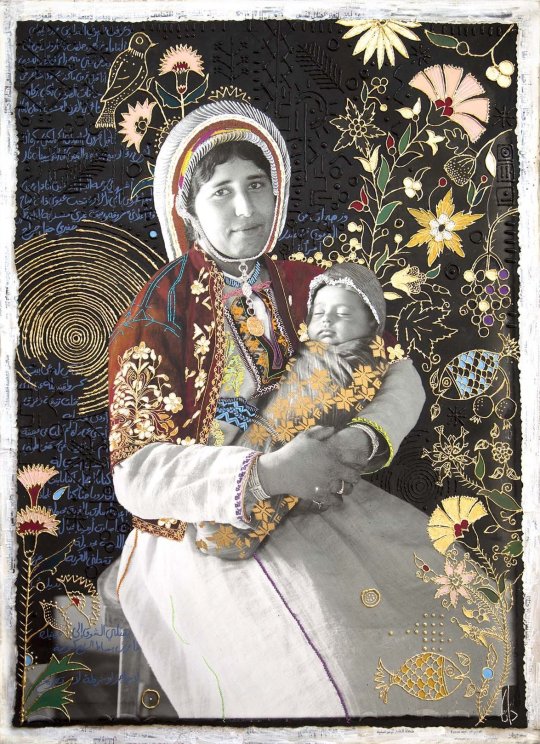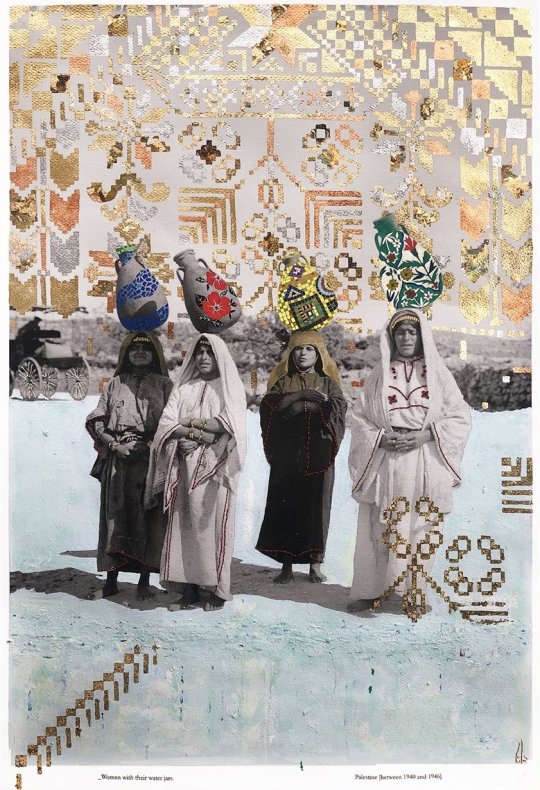#ink’s notes
Note
I would introduce Diavolo to so many simple foods and snacks
big same. apple slices and peanut butter is the first thing i thought of
but also catch me n him eating shredded cheese right outta the bag together
27 notes
·
View notes
Text










A Land Without People series by Palestinian artist Dana Barqawi, 2018
#art#dana barqawi#contemporary art#palestine#palestinian art#middle eastern art#artists of color#women artists#female artists#free palestine#2010s#21st century#mixed media#embroidery#acrylic#ink#palestinian#jamie's favorites#100 notes#250 notes#500 notes#750 notes#1000 notes#2500 notes#5000 notes
7K notes
·
View notes
Text
I am truly a giggler. A laugher. A chuckler. Just somewhere in the background snickering.
#random notes#random thoughts#randomnotebookthoughts#female writers#writers and poets#writers on tumblr#thinking out loud#obsessive daydreaming#spilled ink#words#quotes#text post#feelings#poets on tumblr#poets corner#my own writing#my own thoughts#original writing#my writing#writers#writeblr
4K notes
·
View notes
Text
Writing Notes: Children's Dialogue
Language is extremely complex, yet children already know most of the grammar of their native language(s) before they are 5 years old.
BABBLING
Babbling begins at about 6 months and is considered the
earliest stage of language acquisition
By 1 year babbles are composed only of the phonemes used in the
language(s) they hear
Deaf babies babble with their hands like hearing babies babble
using sounds
FIRST WORDS
After the age of one, children figure out that sounds are related to meanings and start to produce their first words
Usually children go through a holophrastic stage, where their one-word utterances may convey more meaning
Example: "Up" is used to indicate something in the sky or to mean “pick me up”
Most common first words (among the first 10 words uttered in many languages): “mommy,” “daddy,” “woof woof,” “no,” “bye,” “hi,” “yes,” “vroom,” “ball” and “banana”
WORD MEANINGS
When learning words, children often overextend a word’s meaning
Example: Using the word dog to refer to any furry, four-legged
animal (overextensions tend to be based on shape, size, or texture, but never color)
They may also underextend a word’s meaning
Example: Using the word dog to refer only to the family pet, as if dog were a proper noun
The Whole Object Principle: When a child learns a new word, (s)he is likely to interpret the word to refer to a whole object rather than one of its parts
SYNTAX
At about two years of age, children start to put words together to form two-word utterances
The intonation contour extends over the two words as a unit, and the two-word utterances can convey a range of meanings:
Example: "mommy sock" = subject + object or possessive
NOTE: Chronological age is NOT a good measure of linguistic development due to individual differences, so instead linguists use the child’s mean length of utterance (MLU) to measure development
The telegraphic stage describes a phase when children tend to omit function morphemes such as articles, subject pronouns, auxiliaries, and verbal inflection
Examples: "He play little tune" or "Andrew want that"
Between 2;6 and 3;6 a language explosion occurs and
children undergo rapid development
By the age of 3, most children consistently use function
morphemes and can produce complex syntactic structures:
Examples: "He was stuck and I got him out" / "It’s too early for us to eat"
After 3;6 children can produce wh-questions, and relative pronouns
Sometime after 4;0 children have acquired most of the
adult syntactic competence
PRAGMATICS
Deixis: Children often have problems with the shifting reference of pronouns
Children may refer to themselves as "you"
Problems with the context-dependent nature of deictic words: Children often assume the hearer knows who s/he is talking about
AUXILIARIES
In the telegraphic stage, children often omit auxiliaries from their speech but can form questions (with rising intonation) and negative sentences
Examples: "I ride train?" / "I not like this book"
As children acquire auxiliaries in questions and negative sentences, they generally use them correctly
SIGNED LANGUAGES
Deaf babies acquire sign language in the same way that hearing babies acquire spoken language: babbling, holophrastic stage, telegraphic stage
When deaf babies are not exposed to sign language, they will create their own signs, complete with systematic rules
IMITATION, REINFORCEMENT, ANALOGY
Children do imitate the speech heard around them to a certain extent, but language acquisition goes beyond imitation
Children produce utterances that they never hear from adults
around them, such as "holded" or "tooths"
Children cannot imitate adults fully while acquiring grammar
Example:
Adult: "Where can I put them?"
Child: "Where I can put them?"
Children who develop the ability to speak later in their childhood
can understand the language spoken around them even if they
cannot imitate it
NOTE: Children May Resist Correction
Example: Cazden (1972) (observation attributed to Jean Berko Gleason)
– My teacher holded the baby rabbits and we patted them.
– Did you say your teacher held the baby rabbits?
– Yes.
– What did you say she did?
– She holded the baby rabbits and we patted them.
– Did you say she held them tightly?
– No, she holded them loosely.
Another theory asserts that children hear a sentence and then use it as a model to form other sentences by analogy
But while analogy may work in some situations, certainly not in all situations:
– I painted a red barn.
– I painted a barn red.
– I saw a red barn.
– I saw a barn red.
Children never make mistakes of this kind based on analogy which shows that they understand structure dependency at a very young age
BIRTH ORDER
Children’s birth order may affect their speech.
Firstborns often speak earlier than later-born children, most likely because they get more one-on-one attention from parents.
They favor different words than their siblings.
Whereas firstborns gabble on about animals and favorite colors, the rest of the pack cut to the chase with “brother,” “sister,” “hate” and such treats as “candy,” “popsicles” and “donuts.”
The social dynamics of siblings, it would appear, prime their vocabularies for a reality different than the firstborns’ idyllic world of sheep, owls, the green of the earth and the blue of the sky.
MOTHER'S LEVEL OF EDUCATION
Children may adopt vocabulary quite differently depending on their mother’s level of education.
In American English, among the words disproportionately favored by the children of mothers who have not completed secondary education are: “so,” “walker,” “gum,” “candy,” “each,” “could,” “wish,” “but,” “penny” and “be” (ordered starting with the highest frequency).
The words favored by the children of mothers in the “college and above” category are: “sheep,” “giraffe,” “cockadoodledoo,” “quack quack,” the babysitter’s name, “gentle,” “owl,” “zebra,” “play dough” and “mittens.”
BOYS / GIRLS
One area of remarkable consistency across language groups is the degree to which the language of children is gendered.
The words more likely to be used by American girls than by boys are: “dress,” “vagina,” “tights,” “doll,” “necklace,” “pretty,” “underpants,” “purse,” “girl” and “sweater.”
Whereas those favored by boys are “penis,” “vroom,” “tractor,” “truck,” “hammer,” “bat,” “dump,” “firetruck,” “police” and “motorcycle.”
Tips for Writing Children's Dialogue (compiled from various sources cited below):
Milestones - The dialogue you write should be consistent with the child's developmental milestones for their age. Of course, other factors should be considered such as if the child has any speech or intellectual difficulties. Also note that developmental milestones are not set in stone and each child is unique in their own way.
Too "Cutesy" - If your child characters are going to be cute, they must be cute naturally through the force of their personality, not because the entire purpose of their existence is to be adorable.
Too Wise - It’s true kids have the benefit of seeing some situations a little more objectively than adults. But when they start calmly and unwittingly spouting all the answers, the results often seem more clichéd and convenient than impressive or ironic.
Unintelligent - Don’t confuse a child’s lack of experience with lack of intelligence.
Baby Talk - Don’t make a habit of letting them misuse words. Children are more intelligent than most people think.
Unique Individuals - Adults often tend to lump all children into a single category: cute, small, loud, and occasionally annoying. Look beyond the stereotype.
Personal Goals - The single ingredient that transforms someone from a static character to a dynamic character is a goal. It can be easy to forget kids also have goals. Kids are arguably even more defined by their goals than are adults. Kids want something every waking minute. Their entire existence is wrapped up in wanting something and figuring out how to get it.
Don't Forget your Character IS a Child - Most of the pitfalls in how to write child characters have to do with making them too simplistic and childish. But don’t fall into the opposite trap either: don’t create child characters who are essentially adults in little bodies.
Your Personal Observation - To write dialogue that truly sounds like it could come from a child, start by being an attentive listener. Spend time around children and observe how they interact with their peers and adults. You can also study other pieces of media that show/write about children's behaviour (e.g., documentaries, films, TV shows, even other written works like novels and scripts).
Context - The context in which children speak is crucial to creating realistic dialogue. Consider their environment, who they're speaking to, and what's happening around them. Dialogue can change drastically depending on whether a child is talking to a friend, a parent, or a teacher. Additionally, children's language can be influenced by their cultural background, family dynamics, and personal experiences. Make sure the context informs the dialogue, lending credibility to your characters' voices.
Sources and other related articles: 1 2 3 4 5 6 7 8 9 10
Writing Notes: On Children
Writing Notes: Childhood Bilingualism
#writing prompt#writeblr#writers on tumblr#spilled ink#poets on tumblr#writing notes#children#writing tips#literature#writing advice#writing reference#studyblr#langblr#linguistics#dark academia#dialogue#writing resources
3K notes
·
View notes
Text

Kiersten White, The Chaos of Stars
#soul connection#writers on tumblr#writing#poetic#love#poetry#life#literature#brown eyes#love quotes#dark academia#dark aesthetic#light academia#longing#agony#falling in love#lit#spilled ink#spilled thoughts#spilled words#spilled poetry#spilled writing#kawaii#web weaving#web writing#poem#sad poetry#vintage#notes#i love her
2K notes
·
View notes
Text






Dark academia coffee
#dark academia vibes#dark academia moodboard#dark academia#dark academia writing#dark academia aesthetic#writing aesthetic#soft aesthetic#classic#literature#writing#classic books#art of writing#books#booklr#spilled ink#coffee and books#coffee time#coffee table#coffetime#coffee#spilled writing#coffee aesthetic#coffee and ciggaretes#typing#black coffee#spilled words#spilled thoughts#writing notes#writings#my writing
875 notes
·
View notes
Text

2K notes
·
View notes
Text
Astrology Mini Observations #5️⃣

🐈⬛Happy Friday 1️⃣3️⃣th!!!
🧚🏻♂️Having Pisces ruling your third or ninth house is giving major fanfiction writing core. Perhaps you love fantasy genre video games and or books and writing your own fanfiction as well!
🧚🏻♂️Taurus north nodes are leaving a past lifetime of digging deeper into the unseen and unexplained and more into what can be explained and ✨secured✨ being in an earthy fixed sign like Taurus. While emotional security may be important to you (Scorpio south node), your focus is more so on what can be materially secured for you in this lifetime. The house this is in will highlight more so on what area this security will take place as well.
🧚🏻♂️the house in which your chart ruler resides in will tell you what a major focus of your life will be spent in. For example; mine is Jupiter in the 11th and it makes sense as I love connecting with like minded communities and through astrology and spirituality (a Jupiter theme.).
🧚🏻♂️Those with Jupiter as a dominant planet in their chart may be either super optimistic or pessimistic or sway in between the two through out their lives. Faith may be a lesson they need to learn and value and could struggle with it from time to time. Jupiter can rule excess and extremes and it also rules faith and spirituality/optimism. Balance will be important for them and discernment in everything.
🧚🏻♂️Aquarius over the 4th house/IC may represent a neglectful upbringing and parental figures that weren’t really emotionally involved in the raising of their children. You may have an avoidant attachment style by proxy.
🧚🏻♂️Venus in the 8th house individuals may struggle with stalkers or obsessive lovers similar to Venus/pluto aspect people. Having both intensifies these potentials.
🧚🏻♂️having two planets conjunct each other in the same house will greatly enhance the importance of that houses theme in your life. Similar to your chart ruler in that house or a stellium there, this will be a house you’re meant to focus quite a bit of time in and experience.
Until next time!! 🖖🏼👽

#astroblr#astro observations#astrology community#astrology notes#astrology help#astrology blog#astrology tumblr#sidereal astrology#astro notes#astrology#astro community#astro placements#ask#divine feminine#divinemasculine#female writers#writers on tumblr#candids#duality#daily blog#ask blog#blogging#girl blogger#blog#cosmic talks#cosmic vibes#spilled truth#spilled ink#spilled thoughts#send asks
361 notes
·
View notes
Text
It's painful to realize that you're less important than you thought.
#thoughts#words#feelings#writing#quotes#love#notes#phrases#relatable quotes#heartbreak#deep thoughts#spilled writing#spilled poetry#spilled ink#spilled thoughts#spilled words#relatable#life quotes#love quotes
475 notes
·
View notes
Text
Ok. Ok so I've seen people do this with Homestuck. But I already read Homestuck. So let's try something else.
*leans in close to the mic*
10k notes and I will watch Supernatural
#supernatural#spn#ink thinks#do you think if i tagged this destiel it would be seen by more people? im gonna try that#destiel#obligatory 'this won't get 10k notes' which it probably won't. but this is an experiment ofc#....#1k#please stop#5k#STOP STOP PLEASE#10k#well fuck me i guess#yeah so anyone seeing the main post now: yes i have started. the tag is 'on the highway to superhell'
11K notes
·
View notes
Note

For you!

KIBTY!!! THANK YOU, FRIEND!!
4 notes
·
View notes
Text
redraws of the old comic… [shudders]



school is almost out, bear with me u guys
#author’s notes#thequestfortheinkmachinecomics#bendy and the ink machine#mugman#cuphead#babtqftim#felix the cat#tqftimc
964 notes
·
View notes
Text
Aren’t you tired of the space between us?
#random notes#random thoughts#randomnotebookthoughts#female writers#writers and poets#writers on tumblr#thinking out loud#obsessive daydreaming#love poetry#love#spilled ink#words#quotes#icona pop#spotify#text post#feelings#poets on tumblr#poets corner
4K notes
·
View notes
Text
Writing Notes: The Shape of Story

by Christina Wodtke
Start with Conflicted Characters
The character needs a goal, a motivation and a conflict.
The goal can be alien to your audience,
but the motivation must be shared by them, and
the conflict creates struggles that increase engagement.
Paint a Picture
Details transport you into the story.
The world disappears and you have a story play in your head.
Even though there are no literal pictures.
But be careful—Too many details and the story gets bogged down.
Make the Protagonist Suffer
“Be a Sadist. No matter how sweet and innocent your leading characters, make awful things happen to them - in order that the reader may see what they are made of.” (Kurt Vonnegut, How to Write a Great Story)
And when it can’t get any worse, make it worse before it gets better
The two key moments that create the peak of excitement in a story is the darkness before the dawn, and the dawn.
The climax is the moment when the protagonist is either rescued or rescues themself.
In older tales, we saw a lot of Deux ex Machina (the hand of god) rescuing the hero. A hero could be rescued by luck, a partner, another hero…but modern audiences strongly prefer stories where the protagonist helps themself.
Resolution is Boring, Keep it Short
Interest grows with every additional conflict, but once the hero figures out the solution, our fascination collapses.
Don’t natter on while the audience’s mind is drifting.
Also Consider:
You need a good inciting incident to move your protagonist to action.
A setting is more than a place, it’s a situation and a moment in time. A vivid place has details.
Modern audiences prefer “return home changed” to “return home the same.”
EXAMPLES: ARCHETYPAL PLOTS ALONG THE ARC

Boy Meets Girl
Internal conflict is always satisfactory (e.g., she believes love interferes with his career, he believes love interferes with his beer.)
The crises usually revolves around betrayal — lying, cheating — and the climax shows it was a misunderstanding or we get atonement.
The struggle is always about them being separated.
The resolution is about binding them more tightly together than ever.

The Quest
You seek things, and find yourself.
Return home changed and don’t pass go.
Common elements include companions, a mentor, great losses and extreme character arcs.

The Underdog
Even though they do not have a shot in hell, the underdog wants something. They want it so bad.
Common elements include an enemy who blocks their path, and a coach who helps them forward.
In this case, they do not return home changed but rather move into a new life that fits their changed self.

Coming of Age
Naive person has the world teaches them a hard lesson, and they become a better person for it.
Struggle revolve around life sucking and then sucking more.
The hero grows and becomes better because of it, and via new understandings becomes competent.
In some tragedies, the world breaks them.
They can return home changed, but more often they move to a new life they have earned.
More Examples. Justice & Pursuit:


Weaving Multiple Plots:

Weaving multiple plots together to make subplots can further increase tension.
Multiple plots woven together makes the whole story not only unique but very compelling.
#writing notes#plot#narrative arc#writeblr#dark academia#writing reference#spilled ink#writing prompt#writers on tumblr#poets on tumblr#literature#poetry#fiction#story#creative writing#on writing#writing tips#writing advice#writing inspo#writing inspiration#writing ideas#studyblr#light academia#writing resources
1K notes
·
View notes
Text

#writers on tumblr#writing#love#poetic#poetry#life#literature#heartbreak#love quotes#heartbroken#spilled writing#spilled poetry#spilled words#spilled thoughts#spilled ink#artists on tumblr#web weaving#web writing#notes#q#lit#fav#soul connection#dark academia#light academia#poem#aww#writeblr#romantic academia#romance
987 notes
·
View notes
Text
alright let’s get you to bed grandpa

476 notes
·
View notes